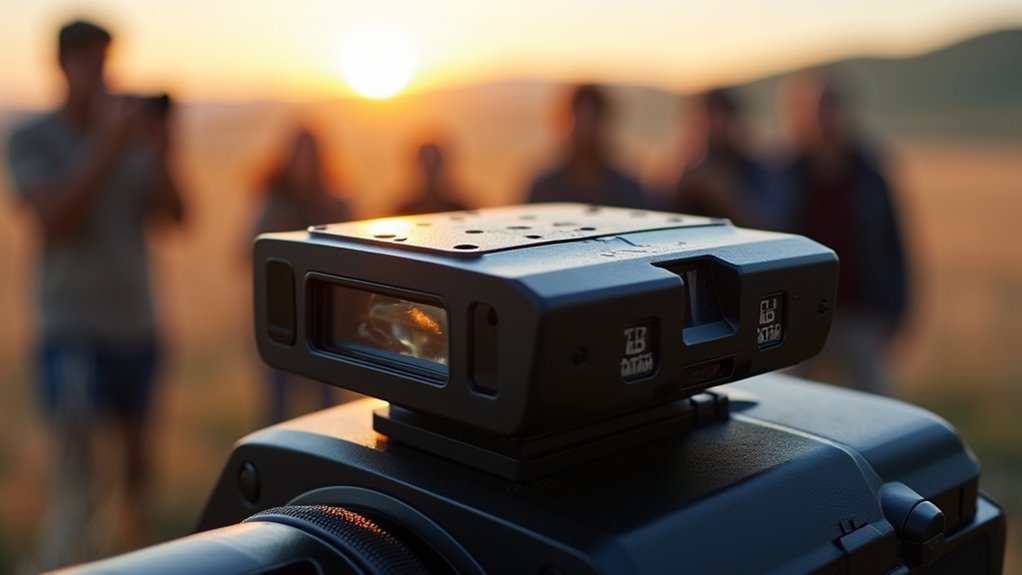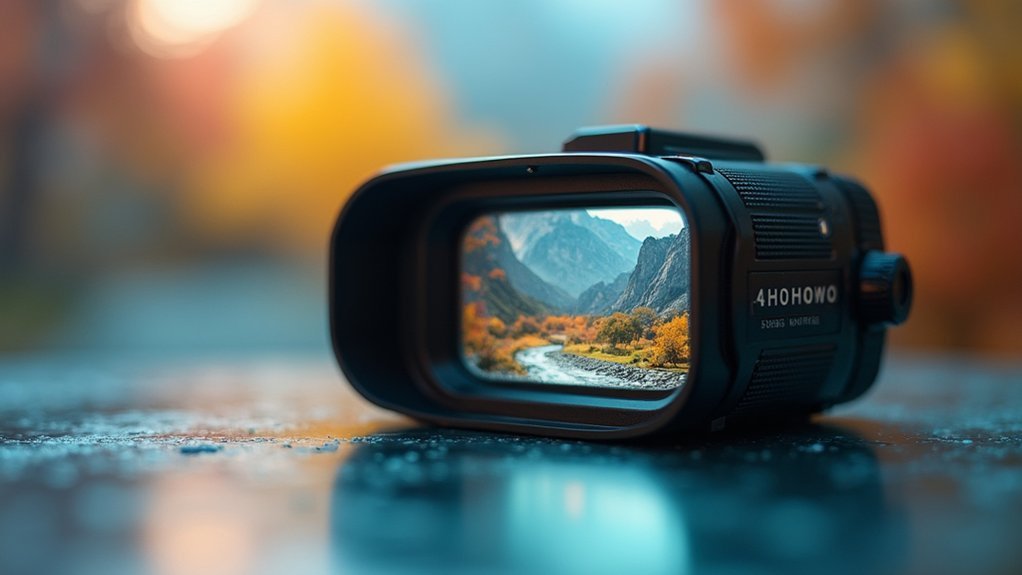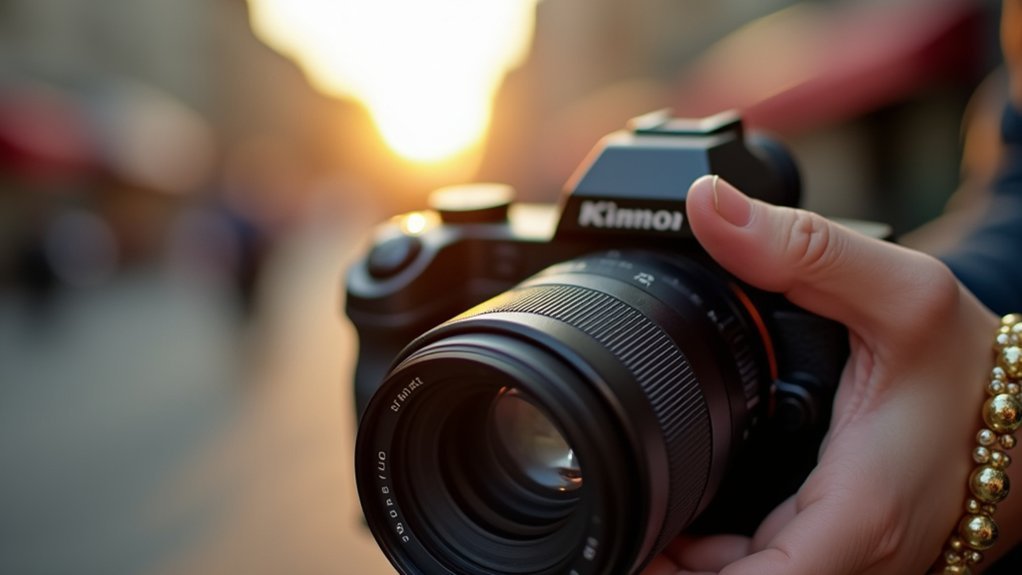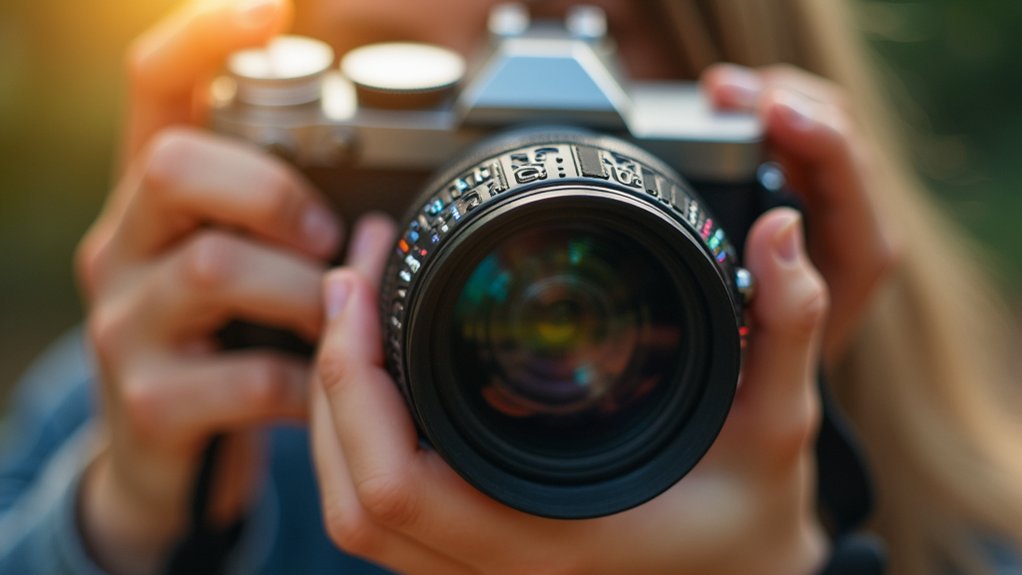Visually impaired photographers need custom viewfinders because traditional optical systems don’t align with their unique vision capabilities. Custom viewfinders project images onto functional parts of the retina, integrate voice and haptic feedback, and enable independent artistic expression without assistance. You’ll gain creative control through AI-powered features that bypass visual limitations while maintaining photographic intent. These innovations don’t just improve accessibility—they’re transforming photography itself by challenging assumptions about who can create compelling visual narratives.
How Custom Viewfinders Bypass Optical Limitations

While traditional camera viewfinders rely on optical precision that many visually impaired photographers can’t access, custom viewfinders offer innovative solutions that work around these limitations.
These specialized tools use focus assist technologies to enhance image clarity and digital displays that can project images onto functional parts of the retina.
Focus assist technologies enhance clarity and project images onto functional retinal areas, creating visually accessible photography experiences.
You’ll find that custom viewfinders reduce dependence on perfect vision by allowing adjustable positioning to utilize your peripheral vision. By tilting or adapting the viewing angle, you can maximize your remaining visual capabilities.
The direct light transmission systems effectively bypass damaged optics in your eyes, making photography more accessible regardless of visual acuity levels. LCD screens provide the benefit of examining images with greater detail and depth when viewed on larger displays.
Some advanced viewfinders integrate with smartphone cameras and provide automatic shooting features, capturing images when your subject is perfectly framed—no precise focusing required.
Targeting Viable Retinal Areas: A Game-Changer for Photographers
For visually impaired photographers, the most revolutionary aspect of custom viewfinders lies in their ability to target viable retinal areas. You’ll discover that these specialized tools work with your functional vision, projecting images directly onto usable portions of your retina, transforming how you frame and focus your shots. This approach aligns with the philosophy that photography is fundamentally a mental operation, regardless of one’s level of sight.
| Technology | Benefit | Emotional Impact |
|---|---|---|
| Retinal Projection | Enhances remaining vision | Freedom to create again |
| Voice Guidance | Real-time compositional feedback | Confidence in your work |
| Haptic Systems | Tactile understanding of settings | Independence from assistance |
| AI-powered Focus | Precision without perfect sight | Pride in technical mastery |
Independent Operation: Reclaiming Creative Control

Because traditional cameras rely heavily on visual feedback, visually impaired photographers have often found themselves dependent on others to confirm settings, framing, and focus.
Custom viewfinders create a path to creative independence, allowing you to make artistic decisions without assistance.
Creative autonomy blooms when tools adapt to your needs instead of forcing you to adapt to theirs.
These innovations can transform your photography experience through:
- Tactile and audio feedback that replaces visual cues for navigation and composition
- Voice-controlled interfaces simplifying menu settings and eliminating screen dependency
- Object recognition technology helping identify and frame subjects in real-time
- Customizable controls tailored to your specific vision needs and preferences
Recent research has shown that sequential information processing is crucial for blind photographers who cannot rely on global processing like sighted individuals.
Technological Innovations Making Photography Accessible
Recent years have witnessed a revolution in assistive camera technology that’s breaking down barriers for visually impaired photographers. You’ll find AI-powered cameras now offering real-time feedback through voice commands, allowing you to adjust settings without seeing the display. These innovative cameras also include automatic scene recognition that makes real-time adjustments to optimize the image quality for different environments.
| Technology | Benefit | Application |
|---|---|---|
| Voice-Controlled Systems | Hands-free operation | Adjusting focus and exposure |
| Smart Assistive Devices | Enhanced composition | Identifying subjects and scenes |
| Modular Design | Customizable experience | Adapting equipment to specific needs |
Smartphones have become particularly valuable with their inclusive algorithms and user-friendly interfaces. These devices combine accessibility features with computational photography to help you capture professional-quality images regardless of visual ability. The integration of AI-driven editing tools further empowers you by automating post-processing while maintaining your creative control.
The Social Impact of Inclusive Photography Equipment

While technological innovations have enhanced camera accessibility, the ripple effects extend far beyond mere gadgetry.
Custom viewfinders aren’t just tools—they’re catalysts for social change, breaking down barriers and challenging preconceptions about who can be a photographer.
When you invest in inclusive equipment, you’re supporting:
- Community empowerment – Giving visually impaired individuals the means to tell their unique stories and perspectives
- Economic opportunity – Creating new markets and job possibilities in accessible technology development
- Cultural enrichment – Enabling diverse voices to contribute to our collective visual narrative
- Social awareness – Challenging stereotypes and educating the public about different abilities through powerful imagery
These impacts transform photography from an exclusive art form into a vehicle for social inclusion and representation. The shift towards accessible equipment counteracts the homogenized portrayal of society that has historically excluded diverse experiences and identities.
Frequently Asked Questions
How Much Do Custom Viewfinders Typically Cost?
You’ll typically pay between $80-115 for custom viewfinders, with 25% discounts sometimes available. Prices vary based on materials, complexity, and special features like magnification. Higher-end specialty models can cost considerably more.
Can Custom Viewfinders Be Installed on Smartphone Cameras?
You can’t easily install physical custom viewfinders on smartphones due to hardware limitations. Instead, you’ll need to use apps, external accessories, or connectivity solutions that allow your phone to function with specialized viewing tools.
Are There Rental Options for Trying Different Viewfinder Adaptations?
Yes, you’ll find rental options through professional houses, peer-to-peer platforms like KitSplit, and specialized services. They offer various viewfinder adaptations with flexible terms, allowing you to test before committing to purchase.
What Training Resources Exist for Visually Impaired Photography Beginners?
You’ll find video tutorials with audio descriptions, workshops like Karsten Hein’s program, online guides, and adaptive equipment training. Blind photography communities also offer mentorship programs and collaborative projects for beginners to learn effectively.
How Do Weather Conditions Affect Custom Viewfinder Performance?
Your custom viewfinder’s performance will suffer in extreme temperatures, high humidity can fog lenses, wind causes stability issues, and varied lighting affects visibility. You’ll need weather-resistant options for consistent results.
In Summary
When you invest in custom viewfinders, you’re reclaiming your photographic voice despite visual impairments. You’re no longer limited by standard equipment designed only for those with perfect vision. By leveraging technology that targets your viable retinal areas, you’re joining a growing movement of independent creators. Your photography isn’t just about adaptation—it’s about expression and belonging in a visual art form that’s rightfully yours too.





Leave a Reply